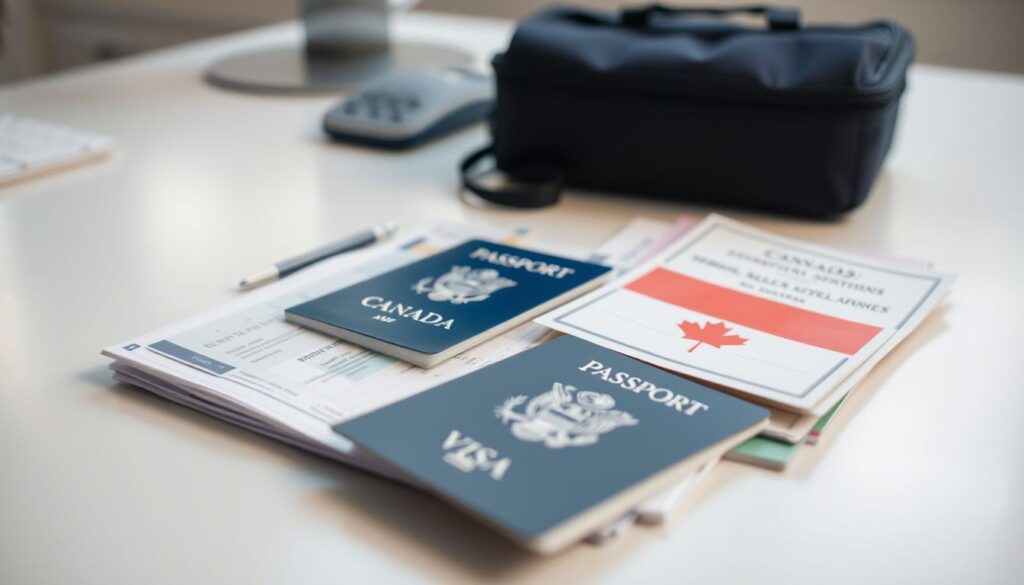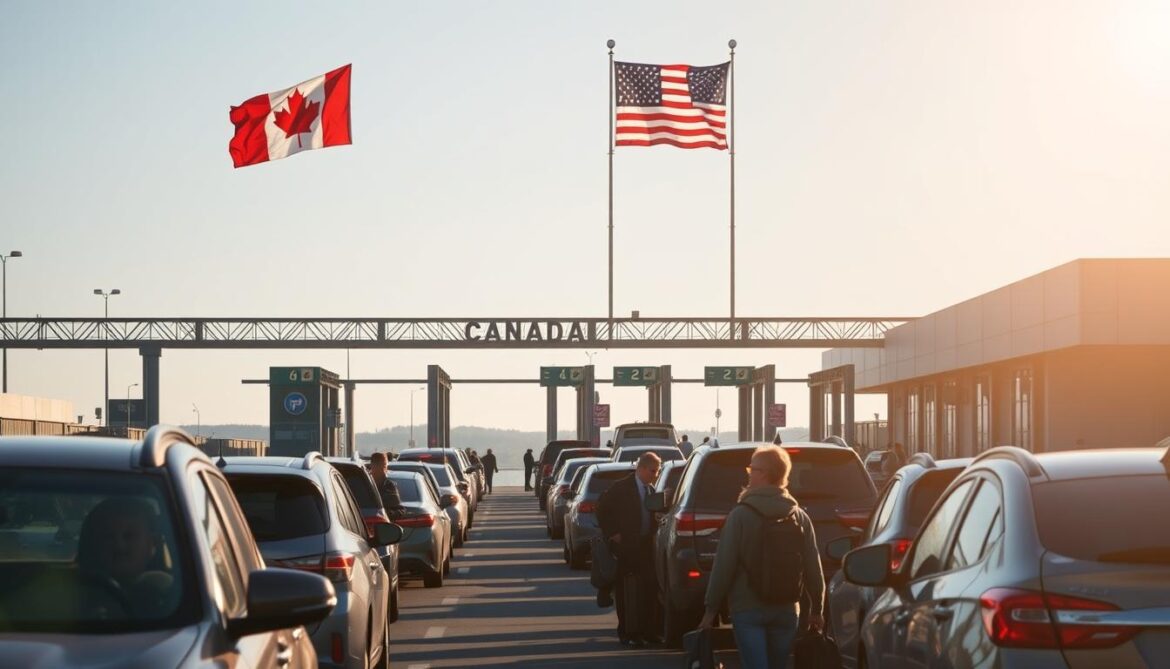Did you know over 10,000 Canadians relocate south of the border each year? Whether it’s for career growth, warmer weather, or a fresh start, the United States remains a top destination. But before you pack your bags, understanding the process is key.
From visa applications to financial planning, every step matters. The Canada visa portal simplifies the paperwork, while services like MTFX help manage cross-border funds. This guide breaks down everything you need for a smooth transition.
Climate, job opportunities, and lifestyle changes often drive this decision. Yet, navigating legal requirements can feel overwhelming. We’ll walk you through the essentials so you’re prepared for the journey ahead.
Why Consider Moving from Canada to the US?
Sunshine, career growth, and cultural diversity await just south of the border. Whether you crave warmer winters or thriving job markets, the United States offers compelling advantages. Let’s explore the top reasons Canadians make the leap.

Better Weather and Lifestyle
Trade snowstorms for sandals. Southern states like Florida boast 300+ sunny days yearly—double some Canadian regions. Mild winters mean year-round outdoor activities, from beach trips to hiking.
Lower population density in sunbelt states like Texas (114/sq mi) also means more space. No more shovelling driveways or layering up for -30°C mornings.
Diverse Job Opportunities
The tech sector alone pays 20-30% more in Silicon Valley versus Toronto. With 45% of Fortune 500 companies based in the US, career growth potential skyrockets.
Did you know? The average tech salary hits $120k USD in California—compared to $90k CAD in Ontario. For skilled professionals, the difference is life-changing.
Cultural and Social Benefits
From Broadway shows to NBA games, the US thrives on entertainment. Over 35,000 museums dot the country, alongside world-class dining and arts scenes.
Major cities like NYC and Los Angeles blend 800+ languages, creating vibrant communities. For families, this diversity enriches education and social connections.
Understanding Visa Options for Moving from Canada to US
Navigating the visa process is the first critical step in your relocation journey. The U.S. offers several pathways, each with unique requirements. Whether you’re pursuing work, study, or family reunification, choosing the right category ensures a smoother transition.
Work Visas: H-1B and TN
The TN visa is a top choice for Canadians under the USMCA, covering 74 professions like engineers and accountants. Approval typically takes 15 business days via CBP. For specialized roles, the H-1B lottery system caps applications at 85,000 annually, with a 65% approval rate for Canadians.
Student Visas (F-1)
An F-1 visa lets you study at U.S. institutions. STEM graduates benefit from Optional Practical Training (OPT) extensions, allowing 36 months of post-graduation work. Ensure your program is SEVP-certified before applying.
Family-Based Immigration
Immediate relatives of U.S. citizens or permanent residents can apply for family-sponsored visas. Processing takes 12–14 months, and you’ll need proof of relationship. The Canada visa portal integrates with USCIS to track applications.
Investor Visas (EB-5)
The EB-5 visa requires an $800,000 investment in Targeted Employment Areas (TEAs) and creating 10 full-time jobs. It’s a route to permanent residency but involves rigorous financial documentation.
Always verify requirements with official sources, as policies evolve. Proper preparation avoids delays in your cross-border move.
Costs and Financial Planning for Your Move
Smart financial planning makes your transition south seamless. Budgeting for visas, daily expenses, and healthcare ensures no surprises. Here’s how to prepare.

Visa and Application Fees
Costs vary by visa type. A TN visa costs just $160 USD, while an H-1B ranges from $4,500 to $7,500 with premium processing. Factor in legal fees if hiring an immigration lawyer.
Cost of Living Differences
Housing savings shine in states like Texas—38% cheaper than Vancouver. But groceries run 15-20% higher near the border. Use U-Pack for affordable moving (around $1,200 CAD for a 1-bedroom).
Healthcare and Insurance Considerations
Unlike Canada’s public system, US health premiums average $456/month. An ER visit can cost $1,200+ uninsured. Research employer plans or private options early.
Remember: State taxes differ—0% in Texas vs. 13.3% in California. Services like MTFX save 2-4% on currency exchange versus banks.
Best US States for Canadians to Relocate To
Choosing the right state can make all the difference in your new adventure. Whether you prioritize sunny beaches, affordable living, or tech careers, these three regions top the list for Canadians.

Florida: Warm Climate and Retirement Appeal
Trade snow for sand year-round. Florida’s 0% state income tax and 300+ sunny days make it ideal for retirees. Vibrant cities like Miami offer condo prices at half the cost of Toronto’s real estate.
Tampa Bay hosts 35,000+ Canadian expats, blending familiarity with coastal perks. From golf courses to art deco districts, it’s the perfect place to unwind.
Texas: Affordable Living and Job Growth
Dallas-Fort Worth housing is 40% cheaper than Toronto. Houston’s energy sector employs 450,000+, while Austin’s tech jobs grew 25% since 2020.
No state taxes mean more savings. Find a home in sprawling suburbs or walkable downtowns—all with Southern hospitality.
California: Tech Hubs and Cultural Diversity
Silicon Valley’s average tech salary hits $165k USD, and California’s GDP outpaces Canada’s. Los Angeles’ film industry drives a $70B economy—time to explore creative careers.
World-class museums, diverse cuisine, and year-round festivals make it a cultural hotspot. Just budget for higher real estate costs.
Steps to Relocate from Canada to the US
Relocating south involves careful planning across multiple stages—here’s your roadmap. Tackling paperwork, securing legal status, and establishing roots require methodical preparation. Follow this phased approach to minimize stress during your transition.

Research and Documentation
Begin by compiling essential documents like birth certificates and professional credentials. The average visa processing takes 6–8 months, so start early. Notify the CRA of your departure date to avoid dual tax liabilities.
Border regulations require IRS Form 8833 for certain treaty-based positions. Cross-border credit challenges mean you’ll need a US score of 650+ to qualify for loans. Services like U-Pack charge $62.02 CAD for customs clearance—factor this into your budget.
Applying for the Right Visa
Match your visa choice to your goals. TN status suits professionals under USMCA, while H-1B visas cater to specialized roles. Consult the Canada visa portal for real-time updates on application queues.
Pro tip: Premium processing speeds up approvals but costs $2,500 USD. Ensure your employer files Labor Condition Applications (LCA) for work visas.
Finding Housing and Settling In
75% of Canadian home seekers use Zillow.com to scout neighborhoods. Prioritize school districts if moving with families—immunization records are mandatory for enrollment. Most states grant a 30-day grace period to transfer your driver’s license.
Choose cross-border banking wisely. RBC USA offers seamless integration with Canadian accounts, while TD Bank provides cross-border mortgage solutions. Your new place should balance affordability with proximity to work hubs.
Essential Documents for Crossing the Border
Crossing the border requires more than just packing bags—it demands precise paperwork. U.S. Customs and Border Protection (CBP) officers verify every document meticulously. A single oversight could delay your entry or result in denied access.

Passport and Visa Requirements
Your passport must have at least six months’ validity beyond your planned stay. For visa holders, carry original approval notices or stamped copies. Tip: Make color duplicates—CBP may request them during secondary inspection.
TN and H-1B workers need employer letters detailing job terms. Students require Form I-20 and proof of SEVIS fee payment. Keep these in your carry-on, not checked luggage.
Customs and Immigration Forms
The I-94 arrival record is now electronic, but you’ll still complete CBP Form 6059B. For household goods, submit Form 3299 72 hours before crossing. Declare cash exceeding $10,000 USD—failure risks seizure.
Immigrant visa holders must present sealed medical exam results (Form I-693). Family sponsors should bring marriage or birth certificates to verify relationships.
Proof of Financial Support
Bank statements must show funds covering at least three times the U.S. poverty guidelines. For a family of four, that’s $78,600 USD annually. Self-employed applicants need business records and tax filings.
Consider carrying a notarized affidavit if relying on a sponsor. USCIS scrutinizes financial stability to prevent public charge concerns.
Financial and Tax Considerations for Canadians in the US
Tax rules differ significantly when you live and work in two countries. The Canada-U.S. Tax Treaty helps avoid double taxation, but filings remain complex. Strategic planning ensures compliance while maximizing savings.
Dual Tax Obligations
As a Canadian in the U.S., you’ll file both IRS Form 1040 and CRA Form NR73. Article XXIV credits offset taxes paid to either country. However, TFSAs face a 1% monthly penalty under U.S. tax law.
Key filings include:
- FBAR for foreign accounts over $10k USD
- State tax returns (varies by residency)
- Estate planning documents for cross-border assets
Managing Investments Across Borders
RRSPs are tax-deferred in the U.S., but withdrawals require careful reporting. Norbert’s Gambit cuts currency exchange costs when transferring funds. Consult a cross-border financial advisor to optimize portfolios.
| Account Type | Canada Tax Treatment | U.S. Tax Treatment |
|---|---|---|
| TFSA | Tax-free growth | Taxable + penalties |
| RRSP | Tax-deferred | Tax-deferred until withdrawal |
Currency Exchange and Money Transfers
Banks charge 3–5% for conversions, while services like MTFX average 0.5%. Time transfers to leverage exchange rate fluctuations. Set up U.S. dollar accounts to minimize fees on recurring expenses.
Remember: Sales tax varies by state (e.g., Texas 6.25% vs. Ontario’s 13% HST). Budget accordingly for daily purchases.
Conclusion
With the right steps, your transition can be smooth and stress-free. Recap your visa options—whether TN, H-1B, or family-sponsored—and budget for fees and living costs. Cross-border financial tools like MTFX save on currency exchange.
Prepared applicants see an 85% success rate. Consult immigration attorneys for complex cases and explore the Canada visa portal for updates. Your new chapter starts with careful planning.
Ready to transfer funds? Use MTFX for low-cost transfers and secure your finances before the move.



